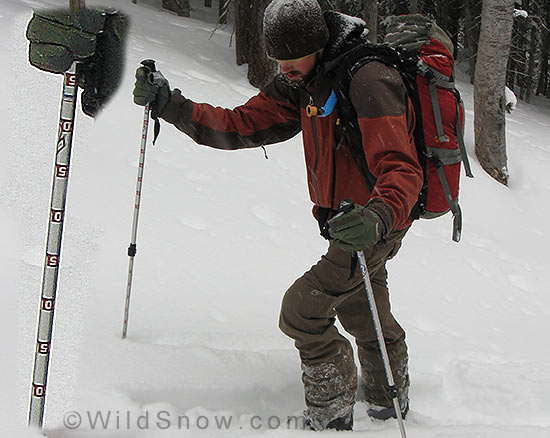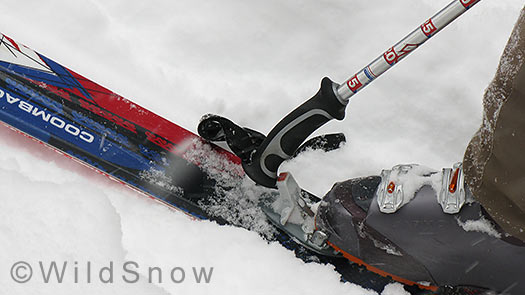
Backcountry skiing with K2 ski poles. Inset photo shows measurement marks on upper pole shaft, used for snow depth and inclinometer.
Although they are more pricey and a bit less durable than fixed length ski poles, I use adjustable ski poles on pretty much every backcountry skiing trip. It is good to be able to have long poles for skinning or skating across a flat section, and helps a lot to be able to shorten them to fit in your pack. If it’s any sort of steep ski mountaineering, my Whippets and I are inseparable, but for powder and “normal” backcountry skiing, I don’t like to run the risk of self-impalement. Hence the need for some basic aluminum adjustable poles as part of my quiver. I’ve tried a lot of adjustable ski poles in the past, and have always gone back to the cam locking type. Ones that lock by twisting or any other method tend to either freeze up or not hold enough and slip. Unfortunately, for some reason, only a few companies make cam locking poles. K2 came out with their adjustable poles in their Back Side line last year — and yes, they are cam lock.

A tiny depression in the grip appears to be designed for operating Dynafit bindings.
K2 makes carbon fiber and aluminum versions of the Lock Jaw backcountry skiing pole. I like aluminum poles, even though they are a bit heavier compared to ones made out of carbon fiber. When I fall on my poles (which happens more than I’d like to admit), aluminum doesn’t splinter like a broken pool cue. Of course, ski poles are all pretty similar, but the Lock Jaw has a few really nice features that make it a great pole for the backcountry.
Perhaps the best Lock Jaw feature is the inclinometer and ruler markings on the upper sections of the poles. An inclinometer is one of the more important tools for determining potential avy terrain, and I try to always have one in my pocket while I’m skiing. I don’t feel this is a replacement for carrying an actual inclinometer, but it is great to have the pole marks if I forget my instrument or if I simply don’t want to dig it out. Overall, perhaps having this feature on ski poles will make people more aware of slope angles — so it’s good for community. (The poles are used as an inclinometer by simply placing one horizontal and one vertical, with the baskets on the slope. You read the angle off the intersection point of the poles. If the poles are held reasonably level and plumb, you get a good reading of the slope angle.)
The pole with the ruler markings is useful for when you jam the grip down in the snow to feel for different layers (and can also be used to measure a large fish you catch). I tend to do this (the depth gauge) a lot on a ski tour, and the depth markings make it way more accurate. For example, if you dig a snowpit that shows a sliding surface a few inches down in the snowpack, it probably isn’t much to worry about, but if you move over to where the wind has deposited more snow, it could be dangerous. The depth marking allows you to keep and eye on such risk factors. Of course you can make marks any poles you have, but it is great to have them accurately marked when you purchase your poles.
Another K2 Lock Jaw ski pole feature is a hardly noticeable little divot on the front upper part of the grip. It’s like they designed this for Dynafit bindings, as the grip divot perfectly grabs and flips the touring lock on my binding toes.
In my now fairly extensive testing every part of these poles is still working fine. I have not had any problems with icing or slippage. They have larger powder baskets, and comfy dual-density grips. My only tweak? The stock poles extend way to long for my uses, so I cut the inner section down a bit to save weight and make the swing action fell less like a war club and more like the ethereal sweep of an angle’s wing as I launch into yet another chain of massive face shots. (Did I write that, or did my editor?)
In summary, this is a solid ski pole with a few “value added” features that make it a fine choice for any backcountry skier. Great gift!
(Guest blogger Louie Dawson is Wildsnow progeny. He currently hails from the wet and scrappy Pacific Northwest, specifically Bellingham WA where he studies industrial design and how much snow falls on Mount Baker — not necessarily in that order.)
Louie Dawson earned his Bachelor Degree in Industrial Design from Western Washington University in 2014. When he’s not skiing Mount Baker or somewhere equally as snowy, he’s thinking about new products to make ski mountaineering more fun and safe.
